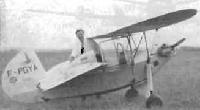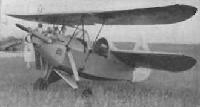Фотографии
-
Регистрационный номер: G-AMYW, KN497 Hunting Aerosurveys' combined-geophysics Dakota 4 (G-AMYW; ex-44-76688) is now flying in further modified form. Compare with ground view in June 1956 "Photo Review": gone are the trio of dorsal "derricks", but additionally there is a ventral D/F loop housing.
Самолёты на фотографии: Douglas DC-3 / C-47 Skytrain/С-53 Skytrooper / Dakota - США - 1935
-
VMF 122 is the first U S Marine Corps fighter squadron to receive the 1,000-m.p.h "plus" Chance Vought F8U-1 Crusader
Самолёты на фотографии: Vought F8U / F-8 Crusader - США - 1955
-
Регистрационный номер: VH-AGB A distant cousin by marriage. Adastra Hunting Geophysics (Pty.) Ltd , of Australia, is currently operating a Consolidated PBY-5A Canso amphibian (VH-AGB) with all the aerial prospecting trimmings. Note unusual removal of wingtip floats.
Самолёты на фотографии: Consolidated PBY Catalina - США - 1935
-
ON SHOW. On 13th January 1908 M. Henri Farman, the well-known pioneer road racer and aircraft designer, completed his first closed circuit of one mile at Issy-les-Moulineaux. Fifty years later this historic event was commemorated by French authorities, who put the original Farman pusher biplane on exhibition at l'Aerogare de Paris. M. Henri Farman attended the ceremony.
Самолёты на фотографии: Voisin Voisin-Delagrange / Voisin-Farman - Франция - 1907
-
TRIPLETS ITALIANO. Twenty-seven pre-production Fiat G.91 (6810-lb. st. Bristol Orpheus B.Or. 12) lightweight strike-fighters have been ordered by N.A.T.O. This new photograph shows a line-up of all three prototypes - each equipped with four fuselage sited 0.50-in. Browning machine guns and underwing pylons for war stores or long-range tanks. The first prototype G.91 (4.520-lb. st. B.Or.2) of 1956, on the extreme right, retains the experimental nose probe.
Самолёты на фотографии: FIAT (Alenia) G.91R - Италия - 1956
-
Регистрационный номер: D-EMIG Another immaculate tandem two-seater, a mid-1930s' vintage Focke-Wulf Fw 44J Steiglitz (D-EMIG). The Fw 44J Steiglitz is powered by a 150-h.p. Siemens Sh 14A radial.
Самолёты на фотографии: Focke-Wulf FW.44 Steiglitz - Германия - 1932
-
U.S. Air Force bases are to be equipped with a specialised airborne crash tender, the Kaman H-43. Shown here is an "on loan" U.S. Navy HOK-1 (BuAer: 125530) bearing temporary U.S.A.F. markings. Note emergency form apparatus.
Самолёты на фотографии: Kaman HTK / HOK / HUK / H-43A Huskie - США - 1951
-
Регистрационный номер: F-PFLN The venerable Caudron C.109 (F-PFLN) of 1928 - rebuilt 1950. The Caudron C.109 is owned by the Aero Club de Perreux et de la Banlieve.
Самолёты на фотографии: Caudron C.109 / C.110 - Франция - 1925
-
Loaned by the U.S.A.F to the Allison Division of General Motors Corpn., this Convair YC-131C (53-7886) made turboprop history on 23rd January. In 649 flights since 1st November 1957 the YC-131C logged the 1,000 hours flying time set as a 1st May 1958 target for "Operation Hourglass' flying at a.u.w. of 48,000 lb. the Allison Model 501-D13-powered YC-131C averaged a cruise of 360-m.p.h. at 20,000 ft.
Самолёты на фотографии: Convair CV-540/CV-580/CV-600/CV-640 - США - 1955
-
Регистрационный номер: VX835 THE ICEMAN COMETH. Better known as the Eland-Varsity flying test-bed, the second prototype Vickers Varsity T. Mk. I (VX835) has been flying recently from Cranfield, Lincolnshire fitted with a 39-nozzle spray rig. Evolved by the Napier Flight Development Establishment, Luton, this spray rig is used to test the behaviour of the N.El.6-standard Eland turboprop under all icing conditions.
Самолёты на фотографии: Vickers Varsity - Великобритания - 1949
-
A new "flat-riser" is the de Lackner DH-5 Aerocycle which has been developed for the U.S. Army from the 1955 DH-4 Heli-Vector. The DH-5 is powered by a 44-h.p. Mercury Mk. 55, which drives coaxially two three-blade main rotors each of 15 ft. diameter. Range is 50 miles at 75 m.p.h.
Самолёты на фотографии: De Lackner DH-4 Heli-Vector / HZ-1 / DH-5 Aero-Cycle - США - 1956
-
Регистрационный номер: F-PGYA [2] Самолёты на фотографии: Mignet HM-18 / HM-19 / HM-210 / HM-360 / HM-380 - Франция - 1936
-
Регистрационный номер: F-PGYA [2] M. Henri Mignet's revolutionary (or retrogressive?) "Pou de Ciel" or "Flying Flea" ultralight of pre-war notoriety has weathered the post-war years and now comes full circle back to France. There are two views of an enclosed cabin, single-seat Henri Mignet H.M.293 (F-PGYA), powered by a 30-h.p. Volkswagen flat-four, giving a cruise of 65 m.p.h. and stalling speed of 25 m.p.h.
Самолёты на фотографии: Mignet HM-18 / HM-19 / HM-210 / HM-360 / HM-380 - Франция - 1936
-
Регистрационный номер: N939M, G-AADR To delight the eyes of an older generation a circa 1929, Chicago-based, de Havilland D.H.60G Gipsy Moth (N939M). At least two other Gipsy Moths are registered in the U.S.A. - N1510V belonging to Paul Mantz and N916M (built at Stag Lane in 1929) owned by Hank Coffin. The latter "stars" in the recent air-racing film, "The Tarnished Angels". The Gipsy Moth is powered by a contemporary 98-h.p. D.H. Gipsy inverted in-line.
Самолёты на фотографии: De Havilland Gipsy Moth / Moth X - Великобритания - 1928
Статьи
- -
- Air Pictorial's photo-review
- Photos by request
- Spotter's Notebook
- ??? - The Macchi M.B.326 Trainer
- ??? - The Saunders-Roe S-R.177
- ??? - The Shape of the Future
- J.Bruce - The Short 320 /Aircraft of 1914-18 War/
- P.Grosz, E.Kruger - Siemens-Schuckert Aircraft 1909-1919 (2)
- R.Cross - Grumman F3F-1
- W.Green - Russia's New Generation













